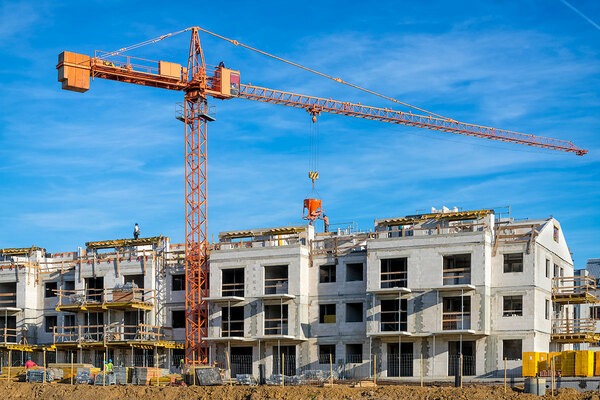You are viewing 1 of your 1 free articles
Government’s planning reforms: what impact will the changes have on affordable housing delivery?
The raft of planning changes put forward by the government last week are set to have a huge impact on the social housing sector. Dominic Brady assesses the reforms and how they will affect affordable housing delivery in the short and long term. Pictures by Getty
When the government published its raft of planning policy changes last Thursday, much of the sector was left scrambling to make sense of the proposals and understand what they mean for the future of housebuilding in the country.
From the introduction of a new zonal system for future planning decisions, which would categorise patches of land as ready for development or protected, to new locally devised planning codes to ensure new homes remain in keeping with the local area, the proposals are far reaching and radical.
And the affordable housing sector must digest and adapt to the changes put forward. Some of the policy decisions look set to have a major impact on affordable housing delivery in the short term and the long term. But just how will the new proposals affect the delivery of affordable housing?
First Homes comes to the fore
It was made clear last week that Robert Jenrick’s First Homes scheme looks likely to become the government’s preferred affordable homeownership product.
The scheme, which applies a 30% discount to market sale prices for first-time buyers, will command a minimum of 25% of all affordable housing units secured through developer contributions under Section 106. On the back of the new proposals, some have raised questions about the future of shared ownership, and whether we will see the same level of shared ownership homes coming to market when the First Homes drive begins.
The government’s consultation on the scheme found that there is widespread demand for a lower First Homes delivery requirement to what the government had put forward in its consultation. The minimum option in the consultation for First Homes delivery via Section 106 was 40% but the majority of respondents (54%) chose ‘other’ as their response, leading the government to revise the percentage to 25%, which it said will support a “smooth introduction” of the scheme.
Duncan Neish, policy officer at the National Housing Federation, explains that there should be more flexibility depending on local need, rather than a blanket figure for all sites. He says that “25% looks like a better level but still we think local authorities should be free to choose and pursue the priorities most suited to their area”.
What is clear from the document released last Thursday is that the government sees First Homes as playing a key role in its future strategy. “First Homes should replace as a priority other affordable homeownership products”, meaning if a local plan has less than 25% earmarked for shared ownership, it will be replaced by First Homes.
The government also said that local authorities will have discretion to increase the discount to 40% or 50% in areas where property prices are particularly high. The discounts are also in perpetuity, meaning that they will apply if the home is resold in future.
First Homes will also be subject to price caps of £420,000 in London and £250,000 across the rest of England.
Small sites to build fewer affordable homes
In an attempt to bring small and medium-sized builders into the picture, the government has proposed a five-fold increase in the affordable housing threshold on smaller sites.
Currently developers can build developments of up to 10 homes without providing any affordable homes, but under the government’s latest proposals this limit could be raised to 50.
In its document last week, the government said: “We are proposing to raise the small sites threshold to up to either 40 or 50 new homes through changes to national planning policy and are seeking views on the most appropriate level.”
The government’s estimates have already found that this will mean a reduction in Section 106 affordable housing between 10% and 20%. However, it argues that raising this threshold will make it a lot easier for smaller builders to get developments off the ground, with Section 106 agreements often slowing down the development process or making small schemes unviable.
Brian Berry, chief executive of the Federation of Master Builders, says: “Local, small builders are ready and waiting to play their part in delivering the homes.” He explains that supporting these groups will support employment and training opportunities and lead to higher-quality, green homes.
Sarah Davis, senior policy and practice officer at the Chartered Institute of Housing, tells Inside Housing that she is concerned about how this will work.
She explains: “In rural areas in particular, where a lot of schemes are small, this will have impact. These communities experience a more critical affordability issue with house prices being much higher than local wages.
“What’s lost in planning gain would need to be made up through direct investment from government.”
The threshold increase will run initially for 18 months, with government monitoring the impact and deciding on whether to continue when that period finishes.
Changes to housing need method
Part of the consultation is looking at changing the planning practice guidance on the standard method for assessing local housing need.
Housing need – an assessment of the number of homes needed in a given area – is calculated via the ‘standard method’ of assessing housing need as defined by the National Planning Policy Framework (NPPF). This method produces a figure of the minimum number of homes expected to be planned for, based on a formula that considers national household growth projections and the affordability of an area.
The government says the new method will improve the current one in four ways:
- It will be more agile as it will use the most recent data. The current standard method uses 2014 projections.
- It will achieve better distribution of homes where homes are identified in higher-demand areas and emerging-demand areas such as the Northern Powerhouse. The government suggests that the current formula underestimates demand for housing in growing cities.
- It will provide stability to the method by smoothing out areas of potential volatility so the basis on which local authorities are expected to plan for is more predictable.
- It will be consistent with the government’s ambition for a housing market that supports 300,000 homes by creating a method with a suitable overall national number that enables the achievement of this aim.
But Mr Neish predicts that in general, local authorities’ housing need will go up under the new regime.
“In London the likely uplift for targets will be about 50%. You will see some places going up and some places going down but the general pattern is targets going up,” he says.
“It does raise a question about how that fits with the levelling-up agenda. We have members in the North who are keen to build more homes – not because of affordability pressures like in London, but there is a case for better quality homes and it’s not heard.”
Exception sites to be retained for First Homes
The government says that it intends to introduce a First Homes exception site policy to provide affordable housing for local people.
Exception sites are used up and down the country and generally take two forms: rural exception sites and entry-level exception sites.
Rural exception sites are small sites used to provide affordable housing for local people in rural areas. In 2018, ‘entry-level exception sites’ were also introduced and are aimed at providing sites for affordable first-time buyer homes.
These sites, defined under the NPPF, allow areas to be used for affordable housing for these in perpetuity where they would not normally be used for non-affordable private tenures.
Under First Homes the government will specify that affordable homes on these exception sites should be First Homes for local first-time buyers.
“There will be the flexibility in the policy to allow a small proportion of other affordable homes to be delivered on these sites where there is significant identified local need as well as a small proportion of market homes where this would be necessary to ensure viability of the site overall,” the government adds.
The threshold that says exception sites should not be larger than one hectare will be removed, although the government will keep the requirement that any site should not exceed 5% of the existing settlement.
Bigger changes to come
Taking the government’s planning reform agenda as a whole, the introduction of First Homes and the raising of the threshold for affordable homes on smaller sites can be seen as the short-term tweaks to the existing planning system. This was reflected in the fact that they were were published in a paper separate to the government’s main planning reform paper.
However, it is the government’s main planning paper titled Planning for the Future in which we can see the longer-term and more drastic changes put forward by the government.
The centrepiece of this paper is a move to a zonal system with land being defined as one of three categories: growth, renewal and protected. Critics of the system have argued that this is undemocratic.
Elsewhere design codes will be created to reflect the local character of an area and ensure that homes fit with plans to build “beautiful” developments. The government will hope these codes can quell fears about build quality – especially since it announced the expansion of controversial permitted development rights.
The current planning system wastes time and taxpayers’ money.
That’s why we’re going to cut the red tape, overhaul the planning process and build better, greener homes faster.
t.co/5sKx8tYIfa pic.twitter.com/JMrjfp6WWS
— Boris Johnson (@BorisJohnson)The current planning system wastes time and taxpayers’ money.
— Boris Johnson (@BorisJohnson) August 6, 2020
That’s why we’re going to cut the red tape, overhaul the planning process and build better, greener homes faster.
https://t.co/5sKx8tYIfa pic.twitter.com/JMrjfp6WWS
For affordable housing delivery, the most significant change is the planned scrapping of Section 106 and the Community Infrastructure Levy (CIL), the two mechanisms in place that ensure private developments include affordable housing and local infrastructure such as roads and schools.
To put into perspective how important Section 106 is to affordable housing delivery, last year 49% of all affordable homes were delivered through Section 106.
Following initial fears that the government did not have a readily available replacement for Section 106, last Thursday it unveiled more details of its plans to keep affordable housing contributions going.
The government wants to replace Section 106 and CIL, and it is adamant that this will result in the same number of affordable homes being built, if not more, as under Section 106.
The proposals include a nationally set value-based charge for developers.
The new charge will be based on the final value of development – with a minimum threshold below which nothing would need to be paid – and be levied at the point of homes being occupied.
Councils would also have the power to decide how to spend the new Infrastructure Levy – with schools, transport and health provision also funded through the mechanism. There is also a suggestion that funding for affordable homes could be ringfenced, and that councils or housing associations could be given first refusal on properties on a given site.
But the development teams at social landlords will be closely watching for details on exactly how it will work.
The overhaul of the planning system is driven by this government’s belief that the current regime is cumbersome and that it blocks the development of much-needed homes.
While many recognise the flaws in the English planning system, there are those who fear that more homes do not necessarily mean more affordable homes, and who are urging the government to ensure this is not the case.
As Mr Neish says: “The changes and the uncertainty around the future of the planning system and the impact on affordable housing reinforces the need for large-scale government investment in social rent homes.”













